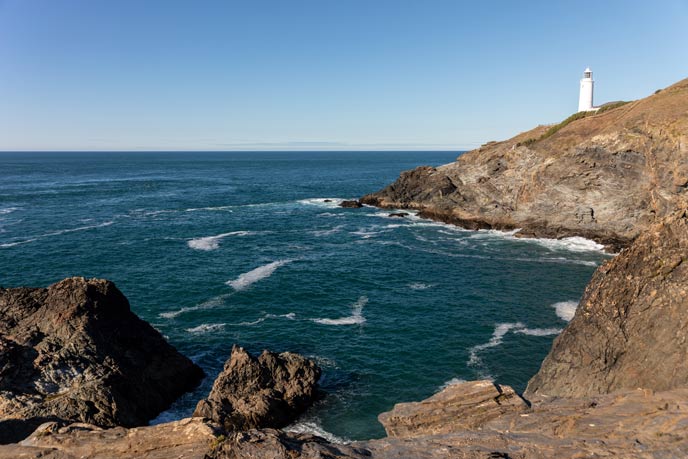Beyond its beautiful beaches and quaint fishing villages, it’s Cornwall’s mining heritage that lies at the county’s geographical and cultural heart. Many of the mine workings and engine houses left behind by this industry have now become popular attractions, and large parts of Cornwall’s old mining regions have been designated a UNESCO World Heritage Site in recognition of the area’s unique and valuable heritage.
Hundreds, if not thousands, of years of mining have inevitably transformed the Cornish landscape. These days, in most places the irrepressible force of nature has reclaimed old ground, once dominated by heavy industry, and transformed it. Many old mining areas have become beautiful havens for wildlife and are now nature reserves, with the added advantage of a fascinating heritage to explore too. Woodland and wildflowers flourish where there was once smoke and bare earth.
So, here is our guide to some of the most picturesque places in Cornwall where you can also discover the region’s industrial and mining past!
Wheal Coates, Chapel Porth, St Agnes

There is something truly magical about Wheal Coates! The remains of the engine houses perched high on the cliff edge above the rolling waves of the Atlantic are incredibly photogenic. In fact, whatever the weather, in the last light of a summer’s evening with the heather in bloom or when the sea is stormy and the whole coastal path is enveloped in spray, this place is just breath-taking.
Most people walk here from the popular surf beach of Chapel Porth that is also famous for its delicious ‘Hedgehog Ice Creams’ at the beach café. Approached from the west, the narrow coastal path leads you right to the first engine house, Towanroath, which towers above you yet is still somehow dwarfed by the scenery. From here, a shaft, still visible today, drops 600ft to the sea below and from there the mine’s tunnels stretch right out under the sea bed.
There are a range of mining ruins nearby that are fun to explore, all while surrounded by the sights, sounds and smells of the wonderful Cornish coast.
Unity Woods, near Scorrier
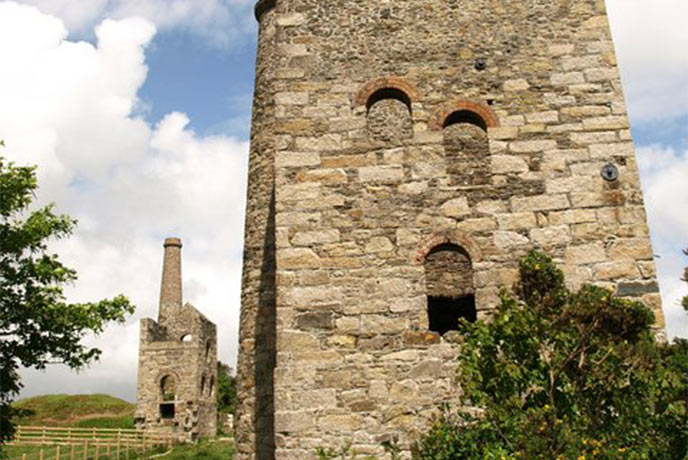
This large area of woodland between St Day and Redruth is famed for its amazing bluebell displays in the spring, and has a network of walking paths that zigzag through the coppiced trees. Just beside the Coast to Coast - Portreath to Devoran Cycle trail, these woods, which before the mines arrived were known as Killifreth meaning ‘speckled grove’ in Cornish, are also popular with mountain bikers and horseriders.
Amongst the trees, however, you will spot a number of capped shafts, which act as an imagination-sparking glimpse into the past. As with all areas that have a mining history, it’s good practice to exercise caution and keep dogs on leads. There are the remains of engine houses all around you in this part of Cornwall, and you can see three mines close to these woods, Wheal Busy, Killifreth Mine and Wheal Unity Wood.
Unity Wood mine opened in 1815 and produced large amounts of copper and some tin before competition with South American and Australian mines caused its closure at the end of the 19th century. The woodland that now bears its name is a prime example of the power of nature to regenerate, and makes a wonderful place to explore and imagine how different this landscape would once have looked.
Tregargus Valley, St Stephen
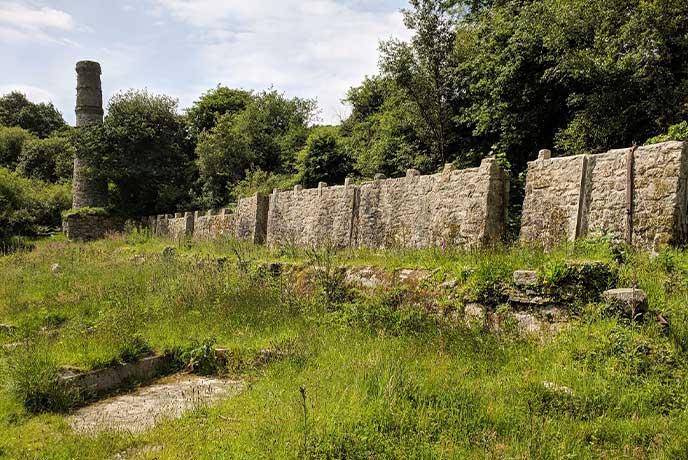
Deep in Cornwall’s Clay Country not far from the world famous Eden Project, which was built in the remains of an old china clay pit, is the deeply wooded valley known as Tregargus. This woodland is another perfect example of nature reclaiming a man-made landscape. This valley was once a hive of industrial activity; huge amounts of china clay was quarried nearby and brought here to be processed and milled for nearly a hundred years, from 1870 until 1965.
Today, the Barn River rushes between the trees, passing the remains of the huge waterwheels and leats it once fed. Wandering the shady paths you can see the old pan kilns and drying areas for the clay alongside old work buildings, bridges and forgotten tramways, all of it taken over by nature - making it a fascinating site to explore.
Tregargus Valley is cared for by volunteers and the Tregargus Trust who work hard to make sure that the remains are preserved and the public can access the site safely.
Gwennap Pit, St Day
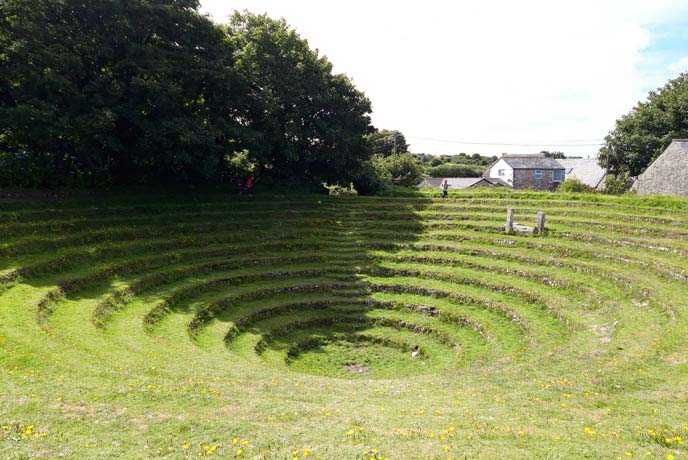
Not far from the old mining village of St Day is one of the most unusual attractions in Cornwall. Gwennap Pit is an open-air ampitheatre, thought to have been formed by the collapse of an old mine working which created a large depression in the earth, this pit was then transformed for the use of the local population.
Gwennap Pit stands in an area that was once known as ‘the richest square mile on earth’ because of the sheer amount of valuable minerals that had been discovered there. This wealth also brought a huge population of miners and their families, and sometime in the 1760s the pit was converted into a preaching pit with terraces for the congregation to sit on. In 1762 John Wesley, the founder of Methodism, came to preach here, attracting a crowd of some 32,000 people. A nearby mine was rechristened Cathedral Mine because Gwennap Pit was deemed the cathedral of Methodism.
Today the pit is free to access and there is a small visitors centre open in the summer months, and information boards with amazing old images of the crowds previously gathered there for services.
Ding Dong Mine, Madron

The distinctive outline of Ding Dong Mine can be spotted on the horizon from miles around, while the views from this mine itself are simply wonderful, with St Michael’s Mount and Mount’s Bay shimmering in the distance and the whole of Penwith laid out before you. The unusual name of this mine is said to come from the fact that the bell of the nearby Madron Church was rung to mark the beginning and end of the miner’s shifts.
High up on the moors of Penwith, Ding Dong is thought to be one of the oldest mines in Cornwall, perhaps in the whole of the UK. It is said that there has been a mine here since prehistoric times and legend has it that Joseph of Arimathea, the uncle of Jesus, once visited the mine in antiquity. The incredible age of the mine is reflected in the landscape that surrounds it, with a number of incredible ancient monuments close to the workings. You will find Lanyon Quoit, Men-an-tol, Bosiliack Chambered cairn and the Nine Maidens Stone Circle all within a short walking distance, as well as Mulfra Quoit and Chun Quoit and castle a little further away, too.
The famous mining engineer and inventor Richard Trevithick worked at Ding Dong in the 1790s, and when the mine eventually closed in 1877 it was a huge blow to Cornwall. The remaining engine house that you see today was listed in 1988 and is very well preserved, surrounded by the remains of shafts and other workings. This is an ideal place for walking and just soaking up the history.
The Cornish Mars, Wheal Maid, Twelveheads

In some instances the disruption caused by mining can take longer to restore, and the landscape in the area nicknamed locally as the Cornish Mars is a strangely attractive example of that. Wheal Maid was a successful copper mine that initially opened in 1782 as part of the Great Consolidated Mine. In the 1970s and 1980s a number of lakes or lagoons were built to hold the waste from the workings.
These ponds, known as the Wheal Maid Tailings, are now infamous for their unusual, otherworldly colours, a result of the minerals in the water, and the lunar type landscape that surrounds them. It is a startling sight to see these reflective pools of water that seem to change their hues constantly.
The local Gwennap council bought the site in 2002 for just £1 and since then have worked to re-wild the area. There are a number of walking and cycling trails and some information boards outlining the history of the mines. The easiest way to access the Cornish Mars is from the Coast to Coast - Portreath to Devoran Cycle trail, you can also walk there from villages of Carharrack or Twelveheads.
Kennall Vale, Ponsanooth

This lush wooded valley, close to Falmouth, features a beautiful rushing river tumbling over huge boulders, and is a popular escape for walkers and nature lovers. Surprisingly, though, Kennall Vale was once the home of a large gunpowder factory.
The river Kennall once boasted more than 30 waterwheels with mills and grinding machinery, and the factory supplied explosives to the surrounding mines for nearly a hundred years. All that remains of this dangerous industry these days are the skeletons of the ruined buildings, a deep flooded quarry, broken waterwheels and leats that once channelled the water that powered the machinery. But somehow these features only add to the beauty and interest of the woodland.
The valley, which once employed hundreds of local people and produced 4000 barrels of gunpowder a year, is now a nature reserve cared for by Cornwall Wildlife Trust. There are marked trails leading you around the site which is alive with bluebells in the spring as well as a variety of birdlife all year round. It is a wonderfully atmospheric location where the ruined remains of its industrial past just enhance its beauty.
Great Flat Lode, Redruth
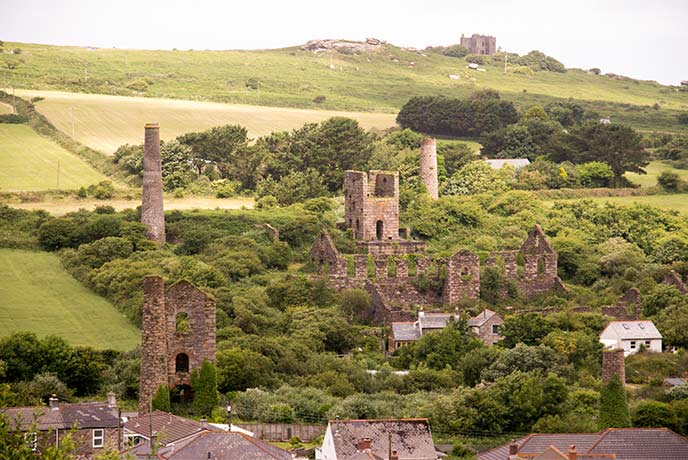
The Great Flat Lode is part of the Mining Trails network, a series of paths and cycle routes that connect the major mining centres in the Redruth, St Day and Camborne area. This trail, which runs for roughly 7 miles, encircles the iconic rocky outcrop of Carn Brea and the route is fairly flat, following part of the Basset Mine Tramway.
Along the path, whether you choose to go on foot or by bike, you will pass the remains of many buildings associated with the mining that once dominated this area. From the large engine houses with their distinctive tall chimneys, such as King Edward’s Mine and Dolcoath Mine, to the remains of a tin smelting site, the Wheal Basset Stamps and the ‘miners dry’ at South Wheal Francis, where the miners could take a bath when they returned ‘to grass’ after their shift deep below ground.
There are plenty of information boards along the way, and lots of opportunities to stop for a picnic or pause to enjoy the views punctuated by the shadows of engine houses in every direction.
Wheal Prosper & Trewavas Mines, Rinsey

Wheal Prosper on East Rinsey cliff overlooks Mounts Bay, Porthleven and the coastline of the Lizard from its perilous position. Opened in 1860 to mine for tin, it now belongs to the National Trust and is part of a lesser-visited mining landscape on Cornwall’s peaceful south coast.
Perhaps the most iconic mines in Cornwall are the Crown Mines at Botallack on the north coast. The breath-taking view of the engine houses perched on the cliff edge was made famous by artists and most recently by Poldark, but there is actually an equally dramatic site close to Rinsey that not many people are aware of – The Trewavas Mines which stand a little further along the coast from Wheal Prosper.
The sight of the two engine houses of Trewavas seemingly hanging in the air above the sea really is impressive. The mine opened in 1834 and was very profitable for several years, with men working in tunnels deep beneath the sea pulling out large quantities of copper. There are reports that in stormy weather the miners could actually hear the waves pounding on the seabed above their heads! Trewavas closed suddenly in 1846 after some of those tunnels flooded. This stretch of coast is well worth seeking out for those classic Cornish views of engine houses silhouetted against the blue sea but without the footfall you often find at Botallack.
If we have inspired you to discover more of Cornwall’s mining heritage then check out our lovely holiday cottages in Cornwall and start exploring!


